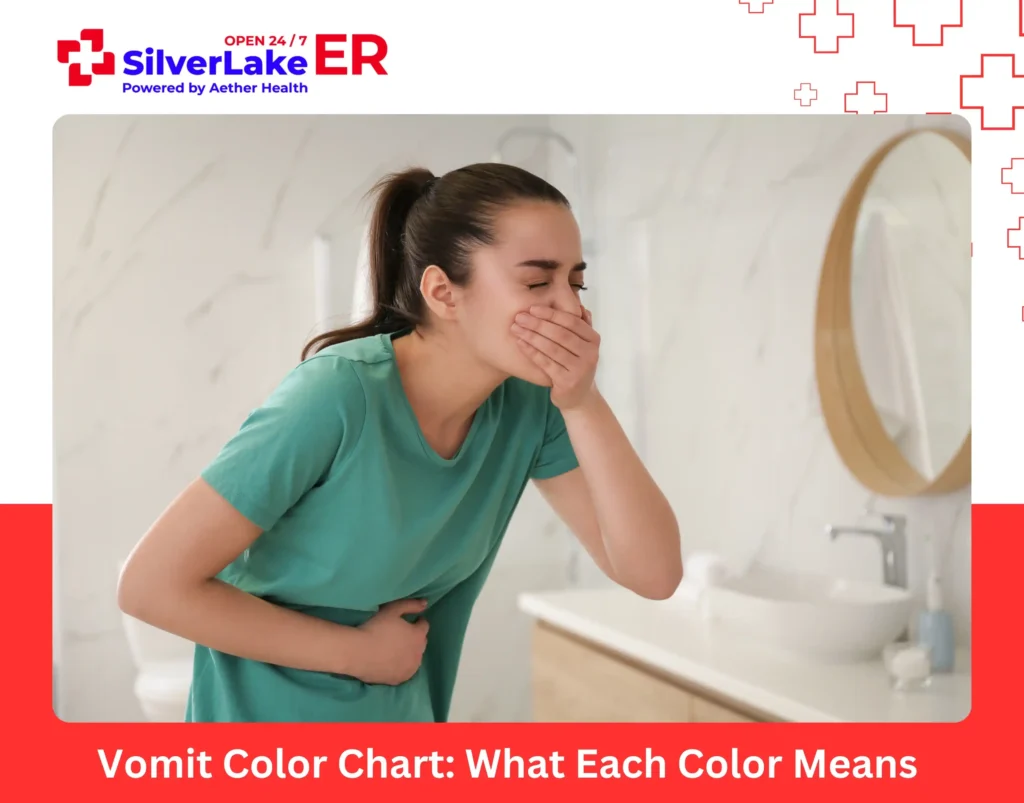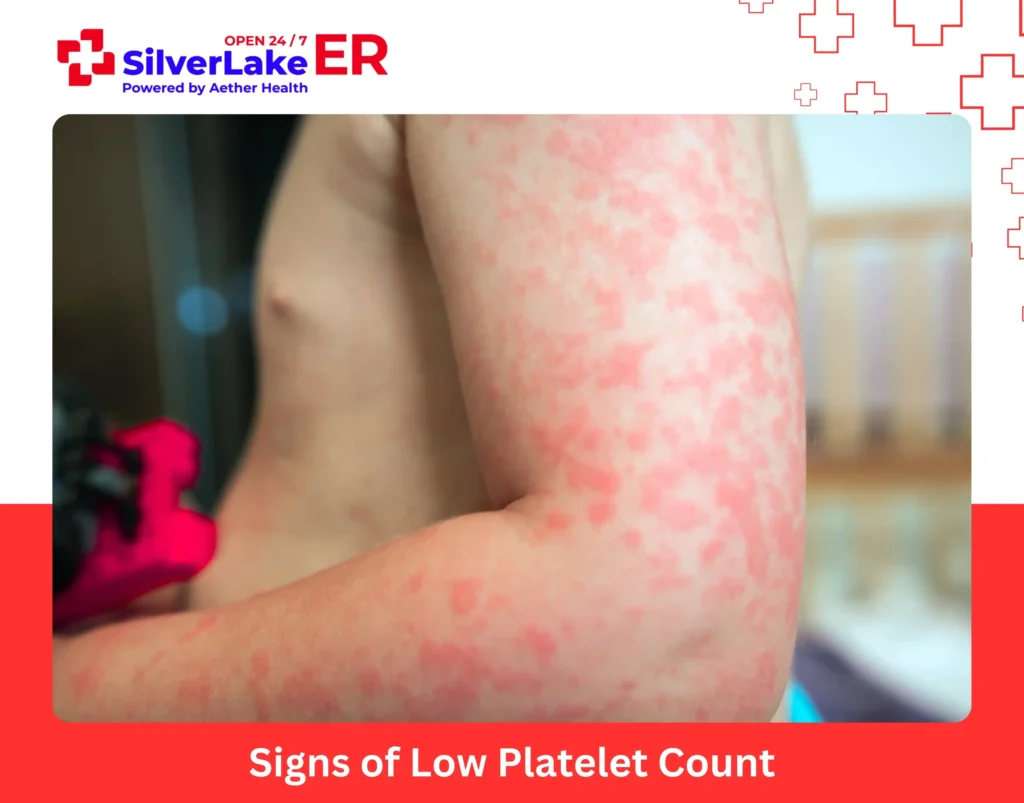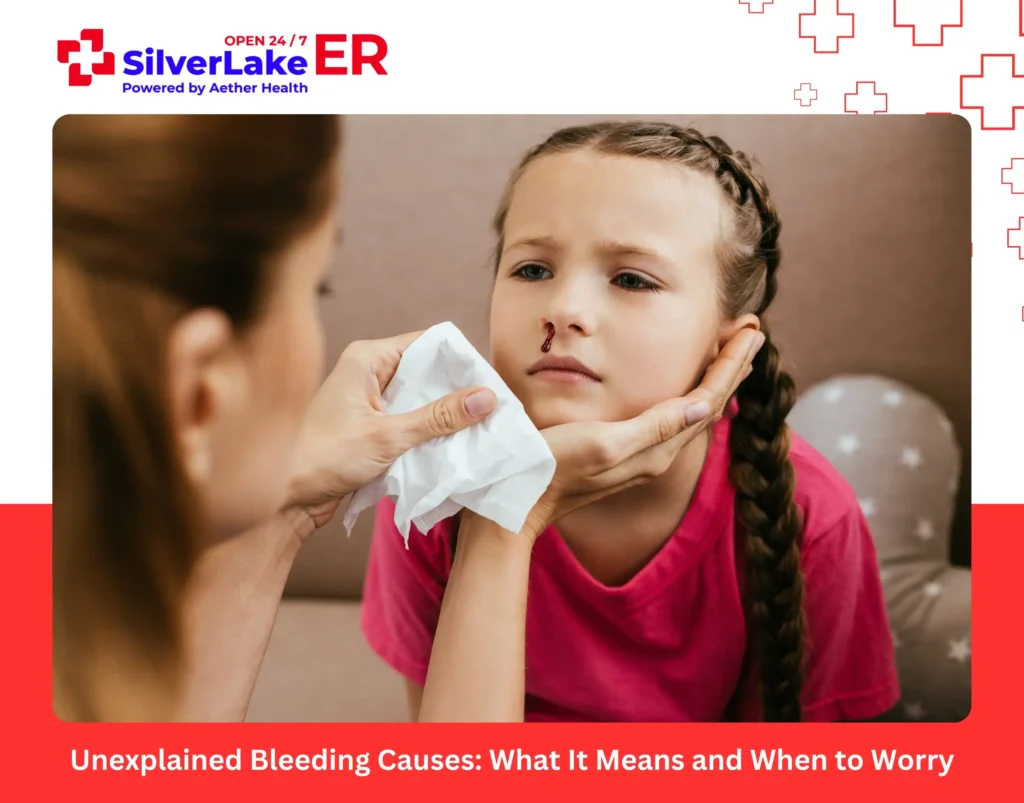Vomit can tell a lot about what’s happening in your digestive system. Doctors use a vomit color chart to quickly assess potential causes. Sometimes, the color is harmless, like when you throw up food or bile after a meal. Other times, it can be a warning of a serious problem, such as bleeding in the stomach or intestines.
The color of vomit depends on several factors: what you’ve eaten, how long food has been in your stomach, and whether there’s bleeding or blockage in your digestive tract. While yellow or clear vomit often signals minor issues like stomach irritation, darker colors like brown or black warrant emergency evaluation.
Let’s break down what each vomit color means and when it’s time to see a doctor for vomiting.
Common Vomit Colors and What They Indicate

Not all vomit looks the same, and each color on the vomit color chart tells a different story about your body’s condition. Here’s a breakdown of what each color may mean and when to take it seriously.
1. Clear or Transparent Vomit
Clear vomit often indicates an empty stomach. It’s mostly water, saliva, or stomach fluid. This can happen when vomiting on an empty stomach or after drinking large amounts of water. Morning sickness, motion sickness, or continued vomiting after the stomach empties often produce this appearance.
What to do: Sip small amounts of water or an electrolyte drink. If vomiting lasts more than 24 hours, see a doctor.
2. White or Foamy Vomit
White or frothy vomit often happens when the stomach is irritated or you’re producing too much acid. It can also appear after eating dairy products or after coughing a lot.
What to do: Avoid heavy, fatty meals and lie on your left side to reduce acid flow. If it happens often, consult a healthcare provider.
3. Yellow or Green Vomit
Yellow or green vomit usually indicates bile is present, a fluid produced by the liver that helps digest fats. It often appears when you’re vomiting on an empty stomach or have stomach irritation.
What to do: Rest your stomach with clear liquids for several hours. Once nausea subsides, try bland foods like crackers or rice. Seek care if bile vomiting continues beyond 12 hours.
4. Orange Vomit
Orange vomit often means food mixed with stomach acid hasn’t fully digested. It’s common in the early stages of illness or when vomiting soon after eating. Food poisoning and stomach flu often produce this color.
What to do: Allow your stomach to rest for 2-3 hours before trying clear liquids. Most cases resolve with hydration and time.
5. Pink or Red Vomit (Fresh Blood)
Red or pink vomit signals active bleeding somewhere in the upper digestive tract. Causes range from esophageal tears (Mallory-Weiss tears) to bleeding ulcers or severe GERD. Even small amounts of fresh blood in vomit require immediate medical evaluation.
What to do: Go to the emergency room immediately. Don’t eat or drink anything until a doctor examines you.
6. Brown Vomit
Brown vomit may contain old blood, bile, or digested food that’s been in the intestines. Bowel obstruction, severe constipation, or bleeding that occurred hours earlier can produce this color. The appearance often resembles chocolate or mud.
What to do: Seek urgent medical care, especially if accompanied by abdominal pain, swelling, or inability to pass gas.
7. Black Vomit or “Coffee-Ground” Appearance
Black vomit or vomit with a coffee-ground texture indicates digested blood from the stomach or upper intestines. This medical emergency suggests significant internal bleeding from ulcers, tumors, or severe gastritis. The dark color develops as stomach acid breaks down blood over time.
What to do: Call 911 or go to the nearest emergency room immediately. Don’t wait for it to pass on its own.
When Vomit Color Indicates an Emergency
Immediate Emergency Room Visit Required
According to our vomit color chart assessment, these colors demand immediate emergency care:
- Red or pink vomit: Fresh blood from active bleeding
- Black or coffee-ground appearance: Digested blood indicating serious internal bleeding
- Brown vomit with severe symptoms: Possible bowel obstruction or old blood
Additional emergency warning signs include:
- Severe dehydration (dizziness, dry mouth, no urination)
- Intense abdominal pain or swelling
- High fever with confusion
- Chest pain accompanying vomiting
- Signs of shock (rapid pulse, cold sweats, fainting)
When to Call Your Doctor
Contact your healthcare provider for:
- Yellow or green bile vomiting lasting over 24 hours
- Clear vomiting that won’t stop despite home care
- Mild blood streaks in vomit (could be throat irritation)
- Vomiting with moderate fever or headache
- Inability to keep fluids down for 12+ hours
What to do When You See an Unusual Vomit Color

Noticing a strange vomit color can be worrying, but your next steps matter most. Here’s what you can do right away.
First-Aid and Self-Care Tips
Start by taking care of your body. Vomiting can quickly drain your energy and fluids.
- Hydrate slowly: Sip small amounts of water or an oral rehydration solution every few minutes. Avoid gulping large quantities, it can trigger more vomiting.
- Rest: Lie down in a comfortable position and keep your head raised slightly. Avoid sudden movements.
- Eat bland foods: Once nausea settles, try plain foods like crackers, rice, or toast. Avoid spicy, greasy, or acidic meals for at least 24 hours.
- Avoid alcohol and caffeine: They irritate the stomach and worsen dehydration.
How to Prevent Vomiting Episodes and Maintain Digestive Health

You can’t always stop vomiting, but small daily habits can strengthen your stomach and help prevent many causes of nausea or acid buildup. Here’s how to keep your digestive system balanced and lower your risk of throwing up again.
- Stay hydrated: Drink water throughout the day, especially after meals. Avoid chugging large amounts at once.
- Eat smaller meals: Large meals can overload your stomach. Try 4–5 light meals instead of 2–3 heavy ones.
- Chew food well: This helps your stomach digest food easily and prevents gas buildup.
- Avoid overeating or eating too fast: It increases stomach pressure, leading to nausea or reflux.
- Wash your hands before eating: Prevents infections that can cause vomiting or diarrhoea.
Conclusion
Understanding the vomit color chart helps you recognize when vomiting signals a serious condition versus a minor stomach upset. While clear or yellow vomit can be harmless, darker shades like brown, red, or black often signal something serious, especially if they come with pain, weakness, or dizziness. Paying attention to these signs and acting quickly can help prevent complications. If you ever notice bloody, dark, or coffee-ground vomit, don’t wait to see if it passes. Seek emergency care right away.
At Silverlake ER, our board-certified doctors are available 24/7 to handle severe vomiting, dehydration, internal bleeding, and digestive emergencies. With on-site lab testing and imaging, you’ll get immediate diagnosis and treatment without the long hospital waits.
Frequently Asked Questions
What does green vomit mean on the vomit color chart?
Green vomit contains bile from your liver and typically appears when vomiting on an empty stomach or after repeated vomiting. While usually not dangerous, persistent green vomit lasting over 24 hours needs medical evaluation to prevent dehydration.
Is brown vomit always an emergency?
Brown vomit requires urgent medical attention as it may contain old blood or indicate bowel obstruction. If brown vomit appears with severe abdominal pain, bloating, or inability to pass gas, go to the emergency room immediately.
What causes black coffee ground vomit?
Black, coffee-ground vomit indicates digested blood from stomach bleeding, often from ulcers, severe gastritis, or tumors. This is a medical emergency requiring immediate ER visit for evaluation and treatment to stop internal bleeding.
When should I worry about blood in vomit?
Any amount of red or pink blood in vomit warrants immediate emergency care. Fresh blood indicates active bleeding in your esophagus, stomach, or upper intestines that needs urgent medical intervention to prevent serious complications.
Can food coloring change vomit color?
Yes, foods and drinks with artificial coloring can temporarily change vomit appearance. Red drinks may mimic blood, while blue or purple foods can create unusual colors. However, if you’re unsure whether it’s food coloring or blood, seek medical evaluation for safety.




